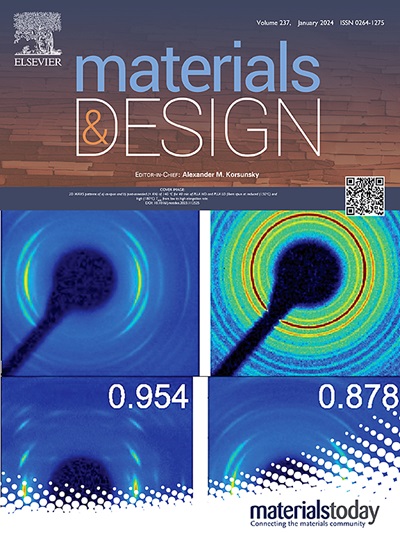压电铜掺杂生物活性玻璃复合敷料抗菌免疫协同调节及伤口愈合
IF 7.9
2区 材料科学
Q1 MATERIALS SCIENCE, MULTIDISCIPLINARY
引用次数: 0
摘要
感染相关伤口愈合困难的核心机制与局部免疫微环境的破坏密切相关。巨噬细胞作为免疫调节的中枢细胞,发挥着举足轻重的作用,其功能失衡是导致愈合损伤的关键因素。因此,我们设计并制造了一种多功能静电纺敷料- PLLA@Cu -通过将铜掺杂的生物活性玻璃(Cu-MBG)纳米颗粒掺入极化PLLA纤维中,从而获得具有压电性能的复合材料。在超声(US)和铜离子(Cu2+)的协同作用下,PLLA@Cu表现出显著的抗菌活性。有效促进M1巨噬细胞极化,显著增强其吞噬和杀菌能力。体内实验证明PLLA@Cu可以快速消灭感染细菌,同时调节巨噬细胞极化,改善创面免疫微环境。这导致胶原沉积增加,血管生成增强,显著加速伤口愈合。此外,该材料通过增加表面能和粗糙度来促进细胞粘附和加速再上皮化。因此,本研究开发的多功能静电纺敷料在治疗感染伤口方面具有很大的潜力,有望成为伤口愈合应用的新型候选材料。本文章由计算机程序翻译,如有差异,请以英文原文为准。

Piezoelectric copper-doped bioactive glass composite dressing for antibacterial-immune synergistic regulation and wound healing
The core mechanism underlying infection-related wound healing difficulties is closely linked to the disruption of the local immune microenvironment. Macrophages, as central cells in immune regulation, play a pivotal role, and their functional imbalance is a critical factor contributing to healing impairment. Hence, we designed and fabricated a multifunctional electrospun dressing—PLLA@Cu—by incorporating copper-doped bioactive glass (Cu-MBG) nanoparticles into polarized PLLA fibers, resulting in a composite material with piezoelectric properties. Under the synergistic effect of ultrasound (US) and copper ions (Cu2+), PLLA@Cu exhibited remarkable antibacterial activity. Additionally, it effectively promoted M1 macrophage polarization, significantly enhancing their phagocytic and bactericidal capabilities. In vivo experiments demonstrated that PLLA@Cu could rapidly eliminate infecting bacteria, while modulating macrophage polarization to improve the immune microenvironment of the wound. This resulted in increased collagen deposition and enhanced angiogenesis, significantly accelerating wound healing. Furthermore, the material promoted cell adhesion and accelerated re-epithelialization by increasing surface energy and roughness. Therefore, the multifunctional electrospun dressing developed in this study holds great potential for treating infected wounds and shows promise as a novel candidate material for wound healing applications.
求助全文
通过发布文献求助,成功后即可免费获取论文全文。
去求助
来源期刊

Materials & Design
Engineering-Mechanical Engineering
CiteScore
14.30
自引率
7.10%
发文量
1028
审稿时长
85 days
期刊介绍:
Materials and Design is a multi-disciplinary journal that publishes original research reports, review articles, and express communications. The journal focuses on studying the structure and properties of inorganic and organic materials, advancements in synthesis, processing, characterization, and testing, the design of materials and engineering systems, and their applications in technology. It aims to bring together various aspects of materials science, engineering, physics, and chemistry.
The journal explores themes ranging from materials to design and aims to reveal the connections between natural and artificial materials, as well as experiment and modeling. Manuscripts submitted to Materials and Design should contain elements of discovery and surprise, as they often contribute new insights into the architecture and function of matter.
 求助内容:
求助内容: 应助结果提醒方式:
应助结果提醒方式:


